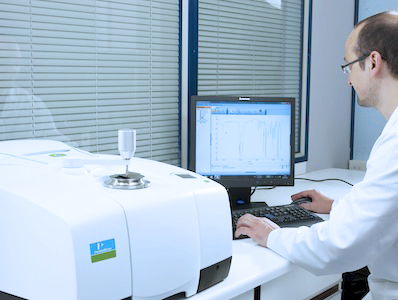 Infrared spectroscopy is an analytical technique used to determine the structures of molecules with the molecules' characteristic absorption of infrared radiation. The technique functions by passing infrared light through a sample resulting in certain frequencies of the light being absorbed by the chemical bonds of the substance, leading to molecular vibrations. The number of absorption peaks is related to the number of vibrational freedom of the molecule. The intensity of absorption peaks is related to the change of dipole moment and the possibility of the transition of energy levels. Therefore, by analyzing the infrared spectrum, one can readily obtain abundant structure information of a molecule. Most molecules are infrared active except for several homonuclear diatomic molecules such as O2, N2 and Cl2 due to the zero dipole change in the vibration and rotation of these molecules. What makes infrared absorption spectroscopy even more useful is the fact that it is capable to analyze all gas, liquid and solid samples. The common used region for infrared absorption spectroscopy is 4000 ~ 400 cm-1 because the absorption radiation of most organic compounds and inorganic ions is within this region.
Infrared spectroscopy is an analytical technique used to determine the structures of molecules with the molecules' characteristic absorption of infrared radiation. The technique functions by passing infrared light through a sample resulting in certain frequencies of the light being absorbed by the chemical bonds of the substance, leading to molecular vibrations. The number of absorption peaks is related to the number of vibrational freedom of the molecule. The intensity of absorption peaks is related to the change of dipole moment and the possibility of the transition of energy levels. Therefore, by analyzing the infrared spectrum, one can readily obtain abundant structure information of a molecule. Most molecules are infrared active except for several homonuclear diatomic molecules such as O2, N2 and Cl2 due to the zero dipole change in the vibration and rotation of these molecules. What makes infrared absorption spectroscopy even more useful is the fact that it is capable to analyze all gas, liquid and solid samples. The common used region for infrared absorption spectroscopy is 4000 ~ 400 cm-1 because the absorption radiation of most organic compounds and inorganic ions is within this region.
Quantum Analytics utilizes a state of the art Fourier Transform Infrared Spectrometer (FT-IR). The spectrometer is comprised of an interferometer which produces an interferogram, and software that carries out the mathematical Fourier Transform function, upon which the final IR absorption spectra is displayed. This instrumentation provides fast acquisition of spectra with high signal-to-noise ratio, high spectral accuracy and resolution, and reduced stray light interference all while allowing the researcher to work with weak signals.
FT-IR spectrometry is widely used in organic synthesis, polymer science, petrochemical engineering, pharmaceutical industry and food analysis. The technique is able to pinpoint the molecular composition and structure of a sample, making it an incredibly useful quality control and troubleshooting tool for manufacturers that need help identifying unknown materials, additives, contaminants, and other material issues and problems.
Applications of FT-IR
- Food & Beverage
- Pharmaceutical
- Liquid Mixtures, Solvent-Solute Mixtures
- Cosmetics
- Fragrances and Essential Oils
- Flavorings
- Resins, Epoxies and Glues
- Creams, Pastes and Gels
- Polymers
- Excipients and Raw Materials
- Fatty Acids
Instruments:
- State of the art FTIR with UATR and Microscopic Imaging System
